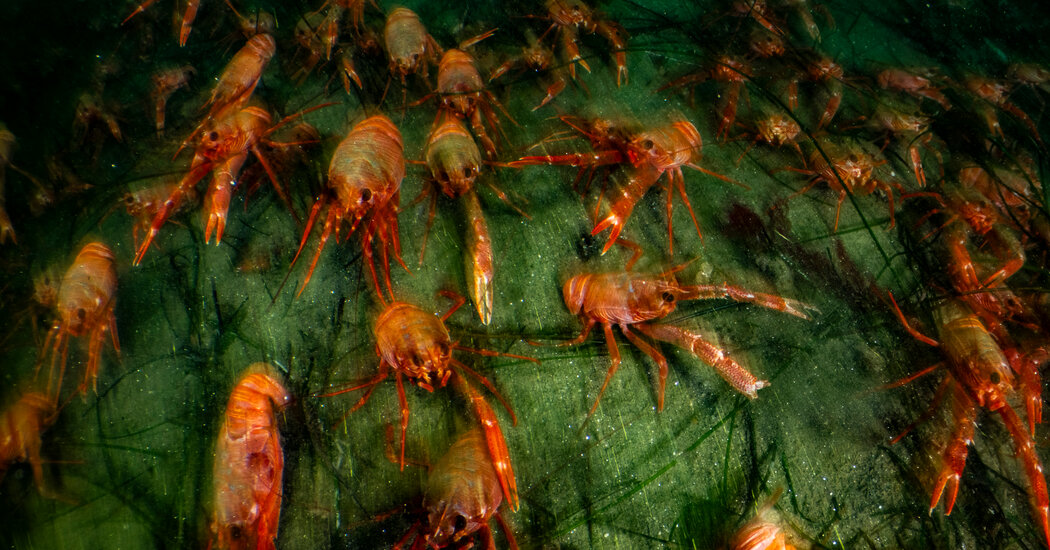When Anna Sagatov, an underwater cinematographer, goes on her usual night dives off La Jolla Shores in San Diego, she’s used to spotting the “occasional octopus, nudibranch and horn shark.” But what she witnessed on a late April plunge was shocking: a seafloor turned red by what she described as an “overlapping carpet of crabs.” Swirling and shifting in the current, the creatures stretched “as far as my dive lights could illuminate,” she said.
The swarming red crustaceans she and other observers have been spotting on San Diego’s coast are called tuna crabs, but they are actually squat lobsters. And the shallows around Southern California are not their usual home.
The animals typically live on the high seas, around Baja California in Mexico. But this is their second appearance in six years in the area. Some experts say they may have been pushed to San Diego’s near-shore canyons by nutrient-dense currents set off by El Niño, when warmer oceans release additional heat into the atmosphere, creating variable currents and air pressure fluctuations over the equatorial Pacific.
The event could signal shifts in the region’s climate. At the same time, the aggregation of tuna crabs offers scientists and divers like Ms. Sagatov a close-up of a sea creature that usually turns up inside a tuna’s stomach.
Some of the observations took twisted turns, like when she began to notice what she called “mass cannibalism” among the red crawlers. While tuna crabs are equipped to eat plankton, they are also opportunistic predators in the benthic stage of their life cycle, which can cause them to feed on their own species.
Tuna crabs are also known as red crabs, lobster krill and langostilla. They are more closely related to hermit crabs than to “true” crabs, even though they have evolved similar features. Their common name derives from their role as a favored food source for large species like tuna during the time in their life cycle when they live in the open ocean.
In the final phase of their life cycle, the crabs descend from the open ocean and live just above the continental crust as bottom-dwellers. In this stage, they will take vertical journeys through the water column in search of plankton, making them susceptible to winds, tides and currents, which may have pushed many of the animals to the north.
On the floor of Scripps Canyon, these crabs form writhing piles, thousands of individuals thick. For local predators, this is a welcome bounty. While many bottom-dwelling tuna crabs are consumed, hundreds of thousands of individuals remain uneaten when the novelty of this new food source wanes.
This aggregation and the one that preceded it in 2018 are mysteries to science, said Megan Cimino, an assistant researcher at the Institute of Marine Sciences at the University of California, Santa Cruz. When tuna crabs last appeared, her team found that their movement in California was “related to unusually strong ocean currents originating from Baja,” sometimes but not always coinciding with El Niño.
She said the new event “signals something different is happening in the ocean.”
While the link between tuna crab aggregations and El Niño isn’t exactly clear cut, “when we think about climate change, the first thing to come to mind might be warming temperatures, but climate change can result in more variable ocean conditions” as well, Dr. Cimino said. She called tuna crabs an “indicator species” able to suggest evidence of large-scale changes in ocean currents and composition that may have positive and negative effects on animals in the area’s waters.
Because of cold water in Scripps Canyon, these crabs won’t last long after settling in San Diego. This mass dying creates stranding events in which tuna crabs wash onto the beaches in droves, turning the sand and the surrounding waters red. Alternately, the same currents that brought the swarm to San Diego could kick them back out to sea.
The end of this invasion could help scientists to one day create a forecasting system for future tuna crab aggregations. It can’t yet be said exactly how long the tuna crabs will stay, or when they’ll return to California’s shores. But in a warming ocean, it may be sooner than anyone expects.
